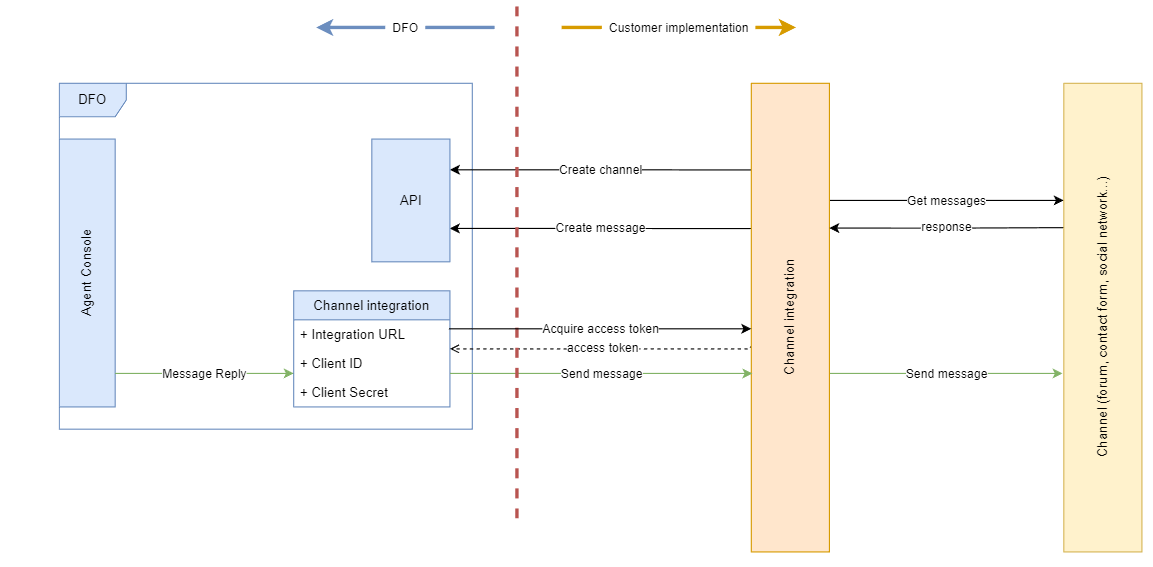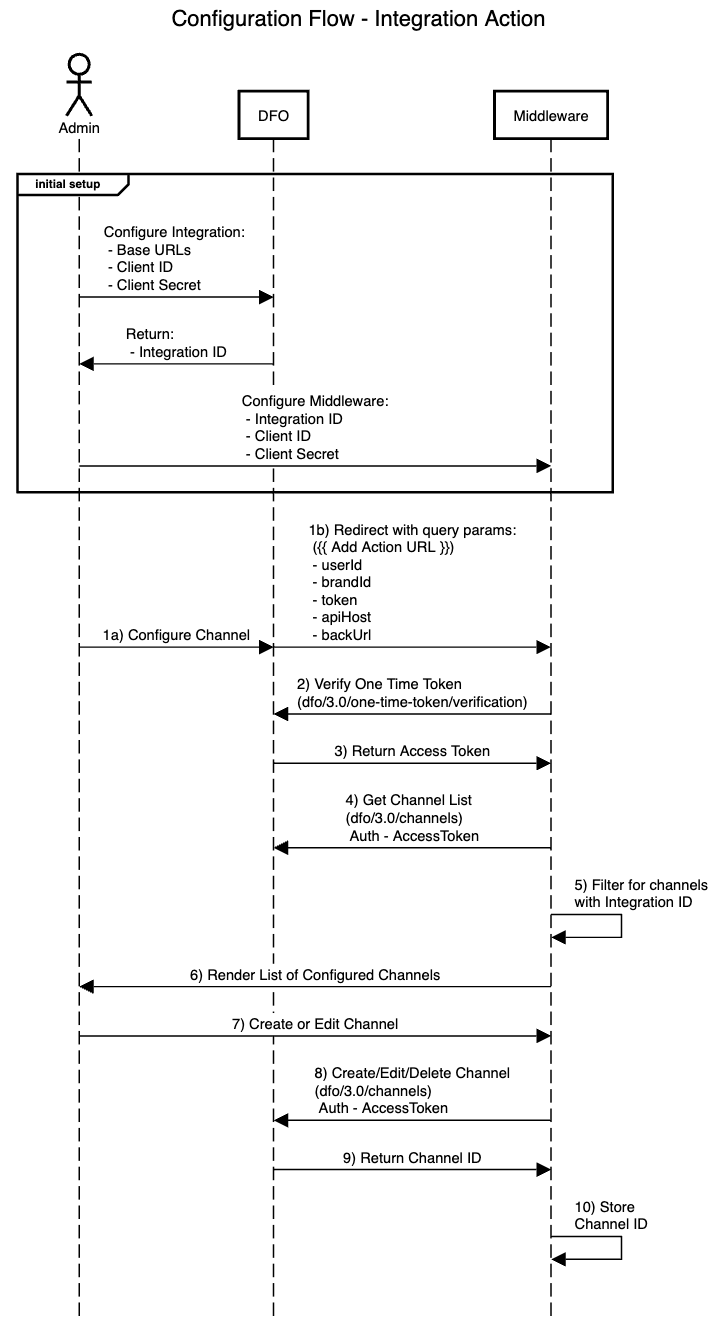Bring Your Own Channel (BYOC) lets you use a digital messaging channel that's not yet supported by CXone Mpower. For the unsupported channel to work with CXone Mpower, you must build and host your own middleware software. The middleware acts like a bridge or adapter between the channel and the Digital First Omnichannel (DFO) platform in CXone Mpower. It translates between two potentially incompatible API specifications and allows them to communicate back and forth. This communication could be, for example, the agent sending a message to the contact. The API specification below explains the APIs that you must implement in your middleware.

The following diagram shows messages being sent back and forth between the CXone Mpower DFO platform and the BYOC channel.

Technical details of the middleware:
The Jungle, Inc. just set up a BYOC integration with The Watering Hole™, a new social media platform that extends their reach to the African savanna market. The Watering Hole™ is a messaging board where animals can post content, plus it also has a live chat where animals can have peer to peer conversations. The Jungle uses the chat widget, which is a front-end integration of the BYOC channel, allowing animals on the savanna to message The Jungle directly with the live chat. When an animal sends an initial message, the middleware uses the DFO Create message API to create a message on the DFOplatform and queue it to the appropriate channel. After an agent accepts the contact and replies, DFO uses the outbound POST messages reply endpoint that's hosted on the BYOC middware to post agents reply to the middleware. Then, the middleware can take that messaging information and display it to the animal along with any other styling. This process continues back and forth until the interaction concludes.
In addition to handling messages back and forth through The Watering Hole™, their developers also solved two scenarios for ending chats: if an animal closes their chat widget and if the agent is required to stop the conversation.
First, if an animal closes their widget, navigates away, or abandons the chat, The Jungle developers set a two-minute timer. If the chat is idle for two minutes, they display a message to the animal, asking if they're still available and begin a 20-second countdown. After the 20 seconds completes, CXone Mpower ends the interaction and the agent can conclude with any dispositions or notes.
Second, The Jungle developers handled when the agent ends a conversation. Perhaps the agent is finished talking, or maybe the animal might be overly angry and belligerent. In these instances, the agent must be able to end the interaction and the angry animal must be prevented from continuing to angrily chat on the thread. The developers used the Digital Engangement APIs to get the status of the thread and stop the customer from replying.
The Watering Hole™ also allows agents from The Jungle, Inc. to send direct messages to animals on the savanna. For these cases, they used the channel/outbound method rather than the reply method since it creates a new message thread. From there, the interaction happens just the same as any other animal-initiated interaction where the middleware calls the create message API to post responses. Then, the DFO platform responds through the reply endpoint since they're sending replies to an existing thread.
If BYOC doesn't fit your use case for integrating an external chat, you may want to use the web SDK.
The following provides a high-level overview of the process to integrate a BYOC channel with CXone Mpower. The CXone Mpower online help provides comprehensive instructions.
The following diagram shows technical details of the overall process.

When building your middleware, be sure to handle two types of authentication:
Digital channels use a concept of a thread. A thread is a group of messages or contacts, depending on the type of channel. For example, it could be a series of chat messages between an agent and a contact. The thread is the object that contains messages, and messages are structured by the author of the messages. For channels like Facebook, a Facebook post is the thread, and elements or members of the thread object contain contacts, which are people who respond to the post. A threadId identifies an entire conversation, and all messages within a conversation has a message ID.
An author is the party who created a message. This could be the agent, whose identifier would be their access token. It could also be a contact who made a Facebook post or responded to a Facebook post. Recipients are receivers of a message. Recipients are not mandatory to configure; they're typically only used for email channels, but could also be used for other channels. For example, the recipient of a Facebook post is the Facebook page. The isPrimary and isPrivate properties are relevant to email recipients. Private recipients indicate that they're CC'd or BCC'd to the email thread. If you configure recipients, set up address validation in the middleware.
The following table explains the different IDs that you must use for BYOC channel API calls.
| ID | Details |
|---|---|
| client_id | Along with the client_secret, these are produced by CXone Mpower when you generate an access token. This token allows you to make API calls as part of OAuth2.0. |
| brandId | The DFO equivalent of a business unit ID. |
| tenantId | The ID of the CXone Mpower tenant. This is the tenant on which the chat channel was created. This is a longer alphanumeric string, such as: 86f85ac-aaed-48e4-9b90-89e31572c627. |
| businessUnitId | The ID of the business unit on which the chat channel was created. You can find this in CXone Mpower under ACD > Business Units in the ACD Configuration section. |
| channelId | The ID of the digital chat channel created in DFO. To set up a BYOC channel, you must create or use an existing digital chat channel. |
| idOnExternalPlatform | This ID shows up in different objects depending on the type of channel. In general, it identifies a thread on the external platform. For example, this could be the ID of a Facebook post or a Twitter user ID. Another example is an SMS channel; this ID would be the contact's phone number. These IDs are supplied by the external platform. For example, you could have thread.idOnExternalPlatform, channel.idOnExternalPlatform, or message.idOnExternalPlatform. |
| ownerUserId | The ID of the user who created the digital chat channel. |
You may see NICE personnel refer to the middleware as an integration box. It could refer to your single service or set of microservices that implement the three main features, inbound messaging, outbound messaging, and the settings UI. The integration box is mainly responsible for mapping the CXone digital platform and the external channel.
The CXone digital platform uses Integration Box URL as a hostname for each endpoint. To ensure compatibility and avoid conflicts with CXone internal routing infrastructure, the defined URL must meet the following criteria:
Not an AWS API Gateway Host:
The URL must not point directly to an AWS API Gateway default host. Specifically, it should not contain:
amazonaws.com
.execute-api.
Recommendation: If you are using AWS API Gateway, configure a custom domain name for your API Gateway endpoint. This ensures better flexibility and avoids potential conflicts with the CXone system.
Valid DNS Record:
The URL must resolve to a valid A record in the Domain Name System (DNS).
Protocol Requirements:
The URL must use a secure protocol, like https://.
Reachability:
The URL endpoint should be publicly accessible and capable of receiving HTTP requests from CXone servers.
The following are CXone Mpower APIs that are frequently used to set up DFO functionality.
POST /channels/{channelId}/messages
POST /channels/{channelId}/outbound
PUT /customers/custom-field-definitions
The following specification explains the APIs that your middleware must provide to the DFO platform in CXone Mpower.